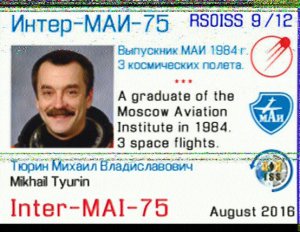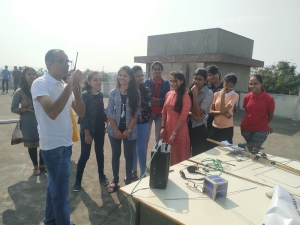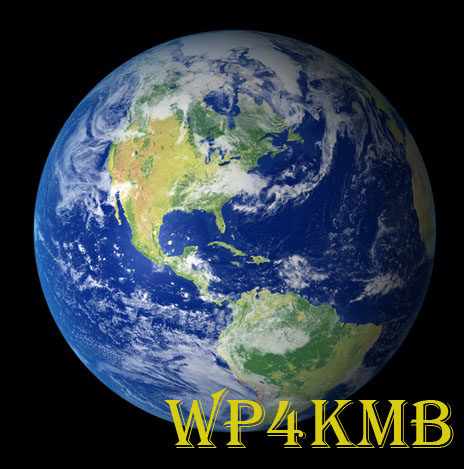ISS SSTV December 28 until January 1
ISS SSTV December 28 until January 1
 Alexei Leonov. Event runs from setup at 1100 GMT on December 28, 2019 until scheduled shutdown at 1820 GMT on January 1, 2020.
Alexei Leonov. Event runs from setup at 1100 GMT on December 28, 2019 until scheduled shutdown at 1820 GMT on January 1, 2020.
Transmissions will be sent on 145.800 MHz FM (5 kHz deviation) in the SSTV mode PD-120. Once received, images can be posted and viewed by the public at http://www.spaceflightsoftware.com/ARISS_SSTV/index.php
ISS SSTV uses a Kenwood TM D710E transceiver which is part of the amateur radio station located in the Russian ISS Service Module.
Please note that SSTV events are dependent on other activities, schedules and crew responsibilities on the ISS and subject to change at any time. You can check for updates regarding planned operation at:
ISS Ham https://twitter.com/RF2Space
ARISS Status https://twitter.com/ARISS_status
ARISS SSTV Blog https://ariss-sstv.blogspot.com/
AMSAT Bulletin Board http://www.amsat.org/mailman/listinfo/amsat-bb
You can receive signals from the ISS when it’s in range of the UK from anywhere in the world using these WebSDR’s, select 145800.00 kHz and FM:
SUWS VHF/UHF/Microwave WebSDR https://amsat-uk.org/2014/03/19/suws-vhfuhfmicrowave-websdr/
144-146 MHz WebSDR at Goonhilly https://amsat-uk.org/2019/08/24/goonhilly-144-146-mhz-websdr/
Read the MagPi article Pictures from space via ham radio
https://www.raspberrypi.org/magpi/pictures-from-space-via-ham-radio/
ISS SSTV info and links https://amsat-uk.org/beginners/iss-sstv/
Get The Details…
m5aka AMSAT-UK
Powered by WPeMatico
TF3YOTA active on Es’hail-2 / QO-100 satellite
TF3YOTA active on Es’hail-2 / QO-100 satellite
 https://tinyurl.com/IcelandIRA
https://tinyurl.com/IcelandIRA
QO-100 information https://amsat-uk.org/satellites/geo/eshail-2/
Get The Details…
m5aka AMSAT-UK
Powered by WPeMatico
CAMSAT CAS-6 satellite launches December 20
CAMSAT CAS-6 satellite launches December 20
CAMST’s amateur radio payload CAS-6 piggybacked on a technology test satellite TIANQIN-1 will be launched at 3:21 UTC on December 20, 2019 at the Taiyuan Satellite Launch Center of China using a CZ-4B launch vehicle.
The primary payload of this launch is China-Brazil Earth Resources Satellite CBERS-4A.
Satellite Name: CAS-6/TIANQIN-1
Orbit:
• Orbit type : SSO
• Apogee : 629km
• Inclination : 97.89˚
• Period : 97min
Satellite Architecture: Micro-satellite
• Mass: 35kg
• Stabilization: three-axis stabilization system with its +Y surface facing the earth
Amateur Radio Payload:
• Call sign: BJ1SO
• VHF Antenna: one 1/4λ monopole antenna with max.0dBi gain is located at +Z side
• UHF Antenna: one 1/4λ monopole antenna with max.0dBi gain is located at -Z side
• CW Telemetry Beacon: 145.910 MHz 17dBm
• AX.25 4.8k Baud GMSK Telemetry: 145.890 MHz 20dBm
• U/V Linear Transponder Downlink: 145.925 MHz 20dBm, 20 kHz bandwidth, Inverted
• U/V Linear Transponder Uplink: 435.280 MHz
CAS-6 Satellites Digital Telemetry Description
CAS-6 CW Telemetry Encoding Format
CAMSAT News Release for CAS-6 Satellite
FloripaSat-1 CubeSat carrying a Digital Repeater payload is on the same launch as CAS-6
https://floripasat.ufsc.br/communication-info/
m5aka
AMSAT-UK
Powered by WPeMatico
Calling Radio Amateurs: Help Find OPS-SAT!
Calling Radio Amateurs: Help Find OPS-SAT!
ESA is challenging anyone with amateur radio equipment to catch the first signals from OPS-SAT, ESA’s brand new space software laboratory.
On December 17, the 3U CubeSat OPS-SAT will be launched into low-Earth orbit on a Soyuz rocket from Kourou in South America, together with ESA’s Cheops exoplanet-tracker.
Lift-off is scheduled for 08:54:20 GMT on Tuesday, December 17. Deployment will begin 15044.6 seconds later (T+15044.6 seconds), expected to be at 13:05:04 GMT.
15 minutes after satellite deployment, when the UHF antenna and solar array deployment have been confirmed, OPS-SAT will begin transmitting 9600 bps GMSK on 437.200 MHz. The first two passes over Europe are expected on the same evening.
The OPS-SAT flight control team has developed open source software which allows anyone to receive the 437.200 MHz beacon of OPS-SAT and decode it.
Full details in the ESA article at http://www.esa.int/Enabling_Support/Operations/Calling_radio_amateurs_help_find_OPS-SAT
OPS-SAT UHF Specification https://github.com/esa/gr-opssat/blob/master/docs/os-uhf-specs.pdf
OPS-SAT GitHub https://github.com/esa/gr-opssat/
m5aka
AMSAT-UK
Powered by WPeMatico
Live Amateur Radio Satellite Demo for Physics Students
Live Amateur Radio Satellite Demo for Physics Students

 https://tinyurl.com/sakshi-talks-sunita
https://tinyurl.com/sakshi-talks-sunita
Students surprised to see scientific capabilities of ham radio reaches up to ISS Astronauts & even further to moon with EME experiments!
Lots of queries were raised on different topics throughout the session, and students as well as faculties were satisfied with the given answers. I always encourage students to raise query at any point of time and get immediate reply 
 https://aprs.fi with Callsign (SSID) VU2EXP-10. To my own surprise group of Faculties stepped out to welcome me exactly on arrival of my car at Campus! Infact everybody were live tracking my journey on APRS!
https://aprs.fi with Callsign (SSID) VU2EXP-10. To my own surprise group of Faculties stepped out to welcome me exactly on arrival of my car at Campus! Infact everybody were live tracking my journey on APRS!
• Star attraction was for Live Satellite Demo amongst group of students. Tiny cubsat AO91 was preferred for demo considering elevation of 44° & AOS Time 1247 (IST). Demo was previously announced to get support of Ham community. All students, faculties and admins get assembled 15 minutes prior to AOS at terrace of the building. There were no obstacles or tall buildings in any side.
I made students familiar with important Satellite terms such as AOS, TCA, LOS, Uplink Freq, Downlink Freq, Doppler shift, Tracking with apps etc. I used IOio dual band antenna with two separate HTs. Necessary frequency & tx ctcss tone was set & tested before pass. For Tx Speaker Mic was used for convenience, and for Rx small PA was connected to HT so whole group can listen to our possible two way QSO. I was prepared aiming IOio antenna at 180° (South), on AOS time at 1247 (IST) I gave few Sat calls… De VU2EXP on AO91 Satellite… repeat… soon heard a station replying me!!! Cheers!!!
Initially his signal was fading, but finally we establish 1st Satellite QSO, it was VU3PEN from Hyderabad (MK97em) 955 Kms from us. Students can’t stop their excitement and started cheering up!!!
Soon we worked 2nd station with VU3BXS from Haryana (MM80pd) 1083 Kms away.
To our surprise 3rd contact was made with DX station A65BP from UAE (LL75qj) 1602 Kms away.
4th contact was with VU2DGR from Kerala (MJ89gg) 1576 Kms away from us.
Now we were near to LOS at NNW direction and at low elevation we heard 5th station, mostly it was R9LR (MO27qf) 3907 Kms away, I gave repeated call but two way contact was not established. Students were very excited to learn such things & just thrilled to witness live SatDemo. Many new queries were answered on SatCom and we had memorable group photo in terrace too.
My session was extended to 4 hours for presentation & various demos.
I am thankful to VU3PEN, VU3BXS, A65BP, VU2DGR & R9LR for extending valuable support for my demo activities. This was my first Live Satellite Demo (AO91) amongst group of students & faculties who all keenly enjoyed whole session.
I also thanks Prof. Harshal Desai, Dr. Savan Katba (Coordinator), Dr. Ashish Tanna (HOD Physics) & School of Science RK University Rajkot to give me wonderful platform to conduct this memorable Ham Session with Live Demos.
Best 73’s
Rajesh Vagadia VU2EXP
Rajkot – Gujarat
Regional Coordinator
West India Zone
AMSAT-INDIA
M: 9898283916
E: vu2exp@gmail.com
http://www.qrz.com/db/vu2exp


 Get The Details…
Get The Details…